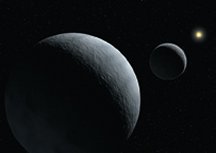Stellar passage yields Charon’s girth
On July 10, 2005, astronomers watched as Pluto’s moon Charon passed in front of a star. The event lasted less than a minute, but that was long enough for researchers operating telescopes in Chile and Brazil to use the star as a backlight to obtain new, more accurate measurements of Charon’s radius, density, and atmosphere.

In the Jan. 5 Nature, two teams report that Charon’s radius is 606 kilometers. Combined with Hubble Space Telescope measurements of Charon’s mass, the new size estimate reveals that the moon has a density 1.71 times that of water—and about one-third the density of Earth.
The rare stellar passage could be seen only from a 980-km stretch of South America. Observations as Charon’s disk passed the star also indicate that if the moon has any atmosphere at all, its density is less than one-millionth that of Earth’s atmosphere, according to Amanda Gulbis of the Massachusetts Institute of Technology and her collaborators. A team led by Bruno Sicardy of the Paris Observatory describes similar results.
The lack of a substantial atmosphere supports the theory that Charon was released when an object struck Pluto. Scientists have similarly proposed that Earth’s moon formed when a giant object struck the young Earth.







